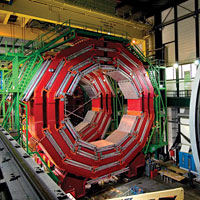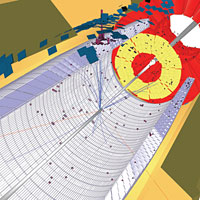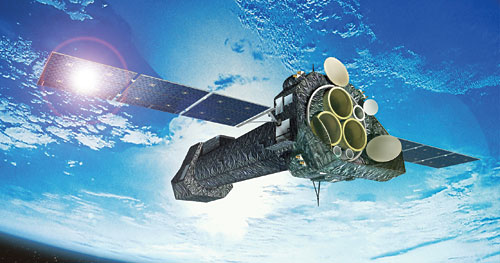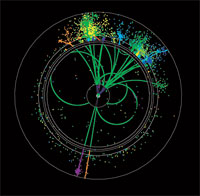GEANT4: The physics simulation toolkit
By Mike Perricone
|
 A GEANT4 visualization of the CMS detector, which weighs in at nearly 14,000 tons. During one second of CMS running, a data volume equivalent to 10,000 copies of the Encyclopaedia Britannica is recorded. Image: CMS collaboration |
 GEANT4 simulation of a super-symmetry event (showing leptons and missing transverse energy), with a Higgs particle decaying to two Z particles and to four muons in the full Compact Muon Solenoid detector. Image: CMS collaboration |
You go to a home supplies store and purchase the oak board for those shelves you need to add to your basement. You haul it home and discover integrated within the wood are instructions for building not just the bookcase but your entire basement redesign, along with all the tools youll need--and the expertise to use them, plus a support group standing by to offer help and suggestions while you cut and drill, hammer and fit.
This do-it-yourself fantasy is not far removed from the way physicists are now working on facilities that include one of the biggest projects ever mounted in science: the development of the proposed International Linear Collider. Serving as combination instruction manual/toolkit/support network is GEANT4, a freely-available software package that simulates the passage of particles through scientific instruments, based on the laws of particles interacting with matter and forces, across a wide energy range. Besides its critical use in high-energy physics (its initial purpose) GEANT4 has also been applied to nuclear experiments, and to accelerator, space, and medical physics studies.
The benefit that has struck me most strongly is the way GEANT4 can be used to help in treating tumors, says Fermilabs Daniel Elvira. The European Particle Physics Laboratory (CERN) and Stanford Linear Accelerator Center (SLAC) are the focal points of GEANT4 resources; Elvira heads up a small but growing GEANT4 team at Fermilab, providing support for individual users and experiment collaborations at the lab. He continues: This is a very nice example how a physics-based tool, developed in a physics environment, has filtered to other communities in such effective ways. Simulations are now used in all places in society. Simulations enable the optimization of designs for better performance with lower costs, in the same way that the Internet saves money through the sharing of information.
Building with objects
GEANT4 is object-oriented in design and function. A segment of data (an object) is encapsulated with the routines or methods that operate on that data. In other words, the information knows how to process itself when a user retrieves it. Almost by definition, GEANT4 can handle virtually any simulation task within reasonable bounds; maybe even within unreasonable bounds.
Practically everything is an object--a detector, a particle, a particle track, a vertex, a hit in the detectors, says Fermilabs Maya Stavrianakou, working with GEANT4 at CERN in the completion stages of the Compact Muon Solenoid detector for the Large Hadron Collider.
The complex CMS detector has about 100 million events used for physics preparation studies. The attributes and interactions of a dynamic particle in the detector can be described and retrieved in GEANT4with all requisite tools and operations attached.
GEANT4 heritage
As with any tool so valuable and easy to use, GEANT4 (from GEometry ANd Tracking) was years in the making--decades, in fact. It also embodies the transition of scientific computing code from the programming language FORTRAN (formula translation), developed by IBM in the 1950s, to C++, the object-oriented language developed in the 1980s. C++ grew from the C language developed in the 1970s at Bell Labs for the UNIX operating system. Ancestors of GEANT4 software written in fortran date back to CERN experiments in the 1980s at the Large Electron-Positron collider, but the specific genesis of GEANT4the current indispensable package--springs from a 1994 proposal to the CERN Detector Research and Development Committee, for rewriting the software code into C++. The proposal was approved as RD44, reporting to the CERN Large Hadron Collider Committee.
But GEANT4 is an ongoing worldwide collaboration as much as it is a software package with worldwide use. The software from its beginnings was an independent project, developed through the efforts of more than 100 scientists from more than 40 institutes and experiments in Europe, Russia, Japan, Canada, and the United States, all signatories to a Memorandum of Under-standing that is renewed every two years. Governance is through a Collaboration Board (CB), a Technical Steering Board, and several workgroups. The Technical Steering Board, chaired by CERNs John Apostolakis, is judge and jury for software and physics issues, for user requests, and for suggested software revisions. Responsibilities of the Collaboration Board, chaired by SLACs Richard Mount, include monitoring the overall allocation of resources.
The CB consists, in the main, of people with the power to allocate resources within their institution, Mount explains. When resource-related issues are brought to the CB, it allows institutional decisions to be made on the basis of a full knowledge of what GEANT4 needs, and what is likely to be available from other parts of the collaboration.
|
|
GEANT4 and ILC
GEANT4 is being used to design three International Linear Collider detector concepts by three interdependent global collaborations. The software used in this design process must provide full simulation capabilities for the whole International Linear Collider physics program, including physics simulations, detector designs, and machine backgrounds, says Norman Graf of SLAC, leader of the North American Detector simulation group. The goal is to have a common simulation environment used in all ILC studies which allows sharing of detectors, algorithms, and code. The system should be flexible, powerful, yet simple to install and maintain.
A detector design must begin somewhere; usually, it begins with the physics motivation and just the barest sketch of a detector. Momentum, angular resolution, and angular acceptance are the crucial parameters. Monte Carlo simulations of particle interactions generate the physics analysis of what will occur inside the detector.
Since the desired precision and performance of the ILC detectors has to be much higher than in previous general purpose collider detectors, Graf says, we have adopted an approach which allows many detectors to be quickly simulated at a reasonable level. We would only proceed to very detailed designs once an overall optimum has been determined. We can also simulate subdetector prototypes, which are built as part of the detector R&D process. This allows a seamless integration of test beam results into the simulation process.
GEANT4 in space
Both NASA and the European Space Agency have benefited from GEANT4 applications in spacecraft design, notably in ESAs Newton spacecraft and NASAs Gamma Ray Large Area Space Telescope (GLAST), a joint project with the US Department of Energy and with agencies in France, Italy, Japan, and Sweden. GLAST will detect gamma rays--high-energy photons--from the central regions of exotic objects like supermassive black holes, pulsars, and gamma-ray bursts. The projected launch is August 2007.
The GLAST Large Area Telescope has four main components: a precision tracker, based on silicon-strip detectors; a calorimeter, using cesium-iodide bars to measure the energy of the cosmic ray particles; a data acquisition system, with 32-bit radiation-hard processors; and an anticoincidence detector to discount the high-energy cosmic-ray background. For all practical purposes, GLAST is a high-energy-physics particle detector in space, and GEANT4 simulations have been on the job in exploring the radiation environment.
Because of the very reliable electromagnetic simulations, we use GEANT4 to simulate our photon signals and to explore how hadrons might sneak into the detector through cracks or through the bottom and try to look like photons, says Richard Dubois of SLAC. We require good EM simulation from a few MeV up to hundreds of GeV.
GEANT4 in medicine
SLAC has become a major US collaborator for medical physicists working on GEANT4 applications, particularly in hadron therapy and brachytherapy for the treatment of tumors. Hadron therapy uses external beams of heavy particles (such as protons) and ions (such as carbon) for cancer treatment--a procedure first suggested by Fermilab founding director Robert Rathbun Wilson in 1946 in his paper, Radiological use of fast protons, published in Radiobiology. Brachy-therapy implants a radiation source close to a cancer, using tubes or catheters. GEANT4 can simulate a typical hadron-therapy treatment beam line and calculate the proton/ion dose distribution curves. It can also calculate the depth-dose distribution in a given material, and illustrate the most effective use of the beam in hadron therapy.
Joseph Perl heads up the effort on medical applications of GEANT4 at SLAC, offering expertise to medical researchers at nearby institutions such as University of California, San Francisco; University of California, Santa Cruz; and Stanford University Medical Center; and working with colleagues at KEK in Japan to develop additional tools to aid medical researchers, such as easy-to-reuse simulations of standard medical-physics dose detectors. Perl has also played a leading role in organizing the GEANT4 North American Medical Users Organization (G4NAMU), launched in May of 2005. G4NAMU brings together the GEANT4 medical user community in North America, to share issues and advice, develop regional collaboration, and communicate as a group with GEANT4 developers. The first major meeting, in July 2005, took place at the annual meeting of the American Association of Physicists in Medicine in Seattle.
SLAC has one of the largest concentrations in the world of GEANT4 expertise, says Perl, comprising experts in all parts of GEANT4 from hadronics and electromagnetics to software kernel, user interface, visualization, and documentation. But the real expertise in medical applications lies with the medical physicists who work in smaller groups throughout the world. Our intention from SLAC is not to replicate that expertise but rather to refine the GEANT4 toolkit to better serve those experts.
Take it to the limits
Solving problems, visualizing complex environments, saving time, saving effort, saving money--how far could GEANT4 take all these advantages? Not as far as making a discovery, Elvira says.
Simulations are an essential part of the work, but they cannot teach us physics that we do not know, he says. We can learn how to search for particles that have certain properties predicted by theorists; for example, the properties of the Higgs boson. But we cannot learn about the properties of new or undiscovered particles through simulations. We cannot replace the experiments. We will always need the experiments.
Click here to download the pdf version of this article.








